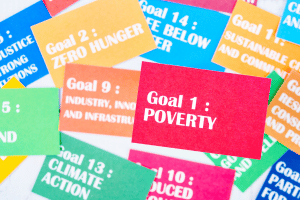The United Nations Sustainable Development Goals (SDGs) present an ambitious agenda to address global challenges and improve people’s lives worldwide by 2030. Achieving these goals requires collective action from all sectors of society, including governments, businesses, non-profits, and communities. In particular, collaboration between the public and private sectors is crucial in driving progress towards the SDGs. These partnerships can catalyze innovative solutions and accelerate sustainable development efforts by combining resources, expertise, and networks.
Collaboration between the public and private sectors is essential for several reasons. Firstly, it leverages the strengths and capabilities of both sectors. Governments possess regulatory authority, policy-making abilities, and access to public resources, while the private sector brings innovation, investment, and market-driven approaches. They can pool their resources and expertise to address complex challenges more effectively by working together.
Secondly, collaboration fosters innovation and creativity. Public-private partnerships (PPPs) encourage exchanging ideas, technologies, and best practices between stakeholders. This cross-pollination of knowledge often leads to the development of innovative solutions that might not have been possible otherwise. For example, partnerships between technology companies and government agencies have created digital platforms for healthcare delivery, education, and disaster response, contributing to progress toward several SDGs.
Thirdly, collaboration enhances accountability and transparency. When the public and private sectors collaborate, they share responsibilities and are held accountable by each other and the communities they serve. This accountability ensures that projects and initiatives are implemented efficiently, focusing on delivering measurable results. Moreover, the transparency of decision-making processes helps build stakeholder trust and promotes sustainable development practices.
Numerous successful partnerships between the public and private sectors have emerged in recent years, demonstrating the potential impact of collaborative efforts on SDG achievement. One example is the Global Alliance for Vaccines and Immunization (GAVI), a public-private partnership to increase vaccine access in low-income countries. By bringing together governments, international organizations, philanthropic foundations, and vaccine manufacturers, GAVI has immunized millions of children worldwide, contributing to SDG 3 (Good Health and Well-being).
Another notable example is the Sustainable Development Goals Fund (SDG Fund), which partners with governments, businesses, and civil society organizations to support projects aligned with the SDGs. Through its innovative financing mechanisms and multi-stakeholder approach, the SDG Fund has implemented over 170 projects in more than 100 countries, addressing issues such as poverty alleviation, gender equality, and environmental conservation.
In addition to global initiatives, collaboration between the public and private sectors is also evident at the local level. For instance, city governments often collaborate with private companies to improve urban infrastructure, promote sustainable transportation, and enhance access to essential services. These partnerships contribute to SDG 11 (Sustainable Cities and Communities), create economic opportunities, and improve the quality of life for residents.
Despite the benefits of collaboration, some challenges must be addressed to maximize its impact on SDG achievement. These include differences in priorities, values, and operating procedures between the public and private sectors and concerns about accountability, transparency, and conflicts of interest. Overcoming these challenges requires building trust, fostering mutual understanding, and establishing clear frameworks for collaboration.
However, collaboration also presents opportunities for innovation and collective action. By harnessing the complementary strengths of the public and private sectors, partnerships can unlock new funding sources, expertise, and technology to address pressing global challenges. Moreover, as the world becomes increasingly interconnected, collaboration will be essential for building resilience, mitigating risks, and creating shared prosperity.
Collaboration between the public and private sectors is indispensable for achieving the Sustainable Development Goals. By working together, governments, businesses, and other stakeholders can leverage their respective strengths and resources to address complex challenges and drive sustainable development. As we strive towards a more equitable, resilient, and prosperous future, fostering partnerships and collaborations will be essential to realizing the vision of the SDGs.



